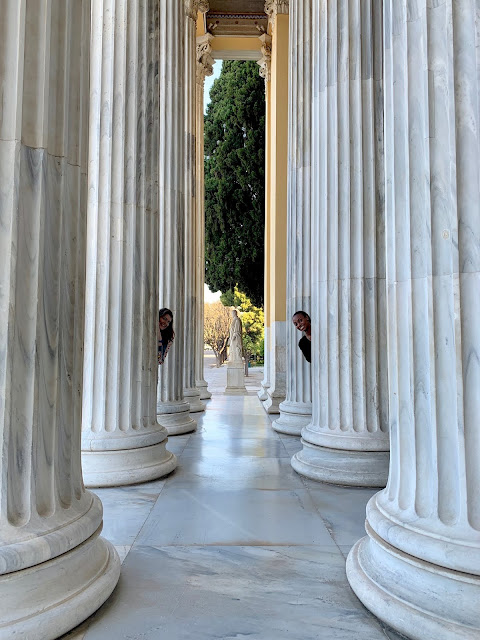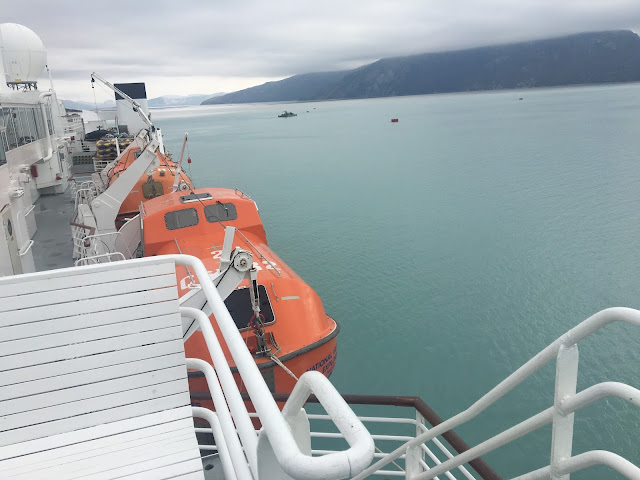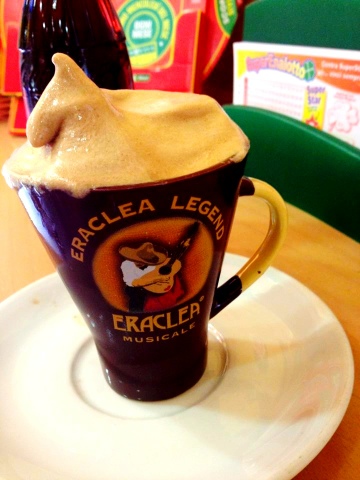Ancient Athens
It sure is easy to get backlogged on writing blogs when we’ve been exploring all day every day! Our trip has been great so far. We’re currently in Slovenia, but let’s back track to the very beginning…
After about 19 hours of travel, we landed in Athens, Greece. Athens is the historical capital of Europe with a long history dating from the first settlement in the Neolithic age. Athens lies 5 miles from the Bay of Phaleron, an inlet of the Aegean Sea where Piraeus, the port of Athens, is situated. When approached from the Middle East, Athens is the first European city and when approached from the west from elsewhere in Europe, the Middle Eastern influence is particularly evident.
Immediately upon landing, we headed to the Blank Wall Gallery at Negri Fokionos 55. A few weeks prior to our departure, I had received an email that my photograph “Smeerenburg Glacier” was selected to take part in an international gallery exhibition. While small, the “Monochrome” gallery exhibition featured photographers from: Greece, Bosnia and Herzegovina, Australia, Russia, Canada, France, Belarus, Germany, Italy, Israel, South Africa, Azerbaijan, Spain, UK, Netherlands, Turkey, Hungary, Poland, Brazil, Malaysia, Bermuda, Poland, Uruguay, Venezuela, India, Scotland, Slovakia, Norway, Sri Lanka, Nigeria, Belgium, and of course the USA.
After exploring the gallery exhibition, we headed to our hotel. The beautiful Hotel Grande Bretagne is located in the center of the city at Syntagma (Constitution) Square. According to one of our guides, Hollywood sometimes blocks off access to the entire square and shoots from the balcony of this hotel, recreating riot scenes. When Greece fell to Nazi occupation in 1941, the 1842 palace hotel was turned into headquarters of the Third Reich. At the end of World War II, the unrest continued as civil war erupted between the communist resistance and the Greek Army. The hotel houses refugees for years while hosting diplomatic negotiations between George Papandreou and the British delegation (most notably Winston Churchill). With peace restored in 1956, the hotel re-opened to the world. When we entered our room, we were treated to views of the Acropolis and the Parliament building, where we could even see the changing of the guard at the Tomb of the Unknown Soldier.
We woke up at 5:30am the next morning to get an early start and beat the crowds.
With a local photographer, we explored some of Athens' less touristy destinations. We began at the Parliament building, in the same square as our hotel, where we photographed the early morning light and symmetrical forms. At one point, a stray dog photobombed our photos, providing some great rim lighting with how the sun was positioned.
The Greek Parliament Building was erected between 1836 and 1842 as the royal palace for King Otto I, the first king of modern Greece. After a fire damaged the building in 1909, the king moved to a nearby building (known today as the presidential palace) and the original palace became known as the “Old Palace”. After the monarchy was abolished in 1929, the Greek government decided to move the parliament from its existing building to the Old Palace and the parliament has resided here since 1935.
From there, we walked through the National Park. The park is a public park measuring 15.5 hectares directly behind the Greek Parliament. Formerly the Kings Garden, you could spend ages wandering through these gorgeous grounds.
We walked through the National Park until we eventually reached Zappeion, a building generally used for meetings and ceremonies (official and private).
Walking adjacent to the Zappeion Gardens, we went to see Kallimarmaro, the stadium where the first Olympic games were held. The Kallimarmaro, or Panathenaic Stadium, is the only stadium in the world built entirely of marble. The multi-purpose stadium has a history that spans over seven centuries. In the 6th century BC, a race course existed on the site of the stadium where the Panathenaic Games (a religious/athletic festival) were held every four years in honor of the goddess of Athena. In 330 BC, an 853-foot limestone stadium was built by the Athenian statesman Lykourgos to host the Panathenaic Games. In 144 AD, Herodos Atticus reconstructed it under Roman rule, in Pentelic marble, with a capacity of holding 50,000 spectators. In the late 4th century, it was abandoned and fell into disuse when festivals were banned by the Roman emperor Theodosius. Excavations in the mid 1800’s revealed traces of the abandoned stadium and it was restored. In 1875, the Zappas Olympics were held and the stadium was further renovated by Anastasios Metaxas for the 1896 Olympic Games. The stadium hosted the first modern Olympics and it was here that the Olympic theme was first heard with lyrics by poet Costis Palamas and music composed by Spyros Samaras.
In the parking lot, there also appeared to be a car show.
We turned back towards the Zappeion building, walking in a slightly different direction to reach the Temple of Zeus and Hadrian’s Arch. The building of the Temple of the Olympian Zeus began in the 6th century but work was stopped either due to lack of money or because Hippias was overthrown in 510 BC. The temple wasn’t finished until Emperor Hadrian completed it in 131 AD, seven hundred years later. Originally, there were 104 Corinthian columns but today only 15 remain standing. Inside the temple, there would have been a gold statue of Zeus though nothing remains today.
Above the ancient road leading from the Acropolis to the Temple of Olympian Zeus, a two-story triumphal arch was erected in 131-2 AD marking the boundary between the old city of Athens and the new city. The arch was erected in honor of Roman Emperor Hadrian, a benefactor of the city. The arch is about 44 feet wide, 59 feet tall and 8 feet thick.
We passed through this arch, where we got stuck in the middle of the street (on a small divider) because the walk signs are so badly timed in Athens. Not to worry... Our guide said this was very normal (though it didn't feel like it with cars whizzing past).
We proceeded to head up through the Anafiotika neighborhood en route to the Acropolis, traveling up the ancient road along the way.
Constructed in the middle of the 19th century by builders from the Aegean island of Anafi, the Anafiotika neighborhood was modeled after their village (since they knew they’d have to spend a few years away from home as the builders were tasked with constructing the palace of the first king of Greece, Othonas).
Anafiotika, which means the neighborhood of Anafiotes (people from Anafi), is less touristy than nearby Plaka. The tiny passageways lined with whitewashed cubist style houses are at the foot of Acropolis Rock and the entire time we were walking around, we didn’t see one other tourist!
After bidding farewell to our fabulous photography guide Spyros, we met our archaeological guide Alexandros to tour the Acropolis and New Acropolis Museum. Acropolis translates to “upper town” and these public monuments are beautifully conserved in one of the densest places in the Mediterranean. To give you a little perspective, out of a population of over 11 million, about half of the population lives in Athens. We first came across the Odeon of Herod Atticus which sits beneath the slopes of the Acropolis on the southwest side.
In ancient times, Odeons were built for musical contests. To this day, the Odeon is used for musical concerts. This building was constructed between 160 AD and 174 AD by the wealthy benefactor of Athens, Herodes Atticus as an ode to his late wife Rigilla. It was the third Odeon built in Athens and was distinctly Roman in contrast to the Theatre of Dionysos. With the Roman arches and three-story stage, it was originally partly covered with a wooden roof. Today, the Odeon seats almost 5,000 people.
We proceeded to make our way through the Propylaea, the monumental entrance to the Acropolis built in 437-432 BC. From here, you can also see the Temple of Athena Nike, a temple in the Ionic order with four monolithic columns at the east and west fronts. As the epithet Nike (victory) implies, Athena was worshipped as the Goddess who stands by the Athenians in time of war. The cella of the temple housed a wooden statue of her and she held a helmet in one hand (a symbol of war) and a branch of a pomegranate tree in the other (a symbol of peace).
From here, we had a glance at the Ancient Agora of Athens, the crowded focal point of administrative, commercial, political and social activity. It was here that Socrates expounded his philosophy.
From here, we made our way to the Erechtheion, a complex marble building in the Ionic order.
The eastern part of the temple was dedicated to Athena, while the western part was dedicated to other gods and heroes. It was a temple with multiple functions, housing older and newer cults and the site of the “Sacred Tokens”—the marks made by Poseidon’s trident and the olive tree, the gift of Athena to the city of Athens.
At the south porch, perhaps the most well-known, the roof was supported by six statues of maidens known as the Caryatids.
A building inscription refers to them as Korai (maidens) though “Caryatids” was assigned at a later time. The second Korai from the western section was removed by Lord Elgin in 1801 and is currently located in the British Museum, a topic of political debate in Athens (as the Athenians want the sculpture back). While the maidens look the same, they were separately carved in Parian marble and affixed on slabs of grey Eleusinian limestone. Continuing on, we reached the Parthenon (currently undergoing a 44 year renovation project).
Erected on the Acropolis in the mid-fifth century BCE, the Parthenon is a culmination of a century-long effort to build a temple with perfect proportions. It was constructed in consistency with the thinking of philosopher Pythagoras of Samos who believed that beauty resided in harmonic numerical ratios, and architect Iktinos calculated the dimensions of every part of the Parthenon. The Parthenon was dedicated to Athena Parthenos (the Virgin) but it also celebrated the Athenian people who, a generation earlier, led the Greeks in their successful effort to defeat the Persians after they had sacked the Acropolis in 480 BCE. Under the direction of Phidias, a team of sculptors decorated the building with statues and reliefs that alluded to the victory over the Persians.
At the flag pole of the Belvedere, we took in the views of the Temple of Zeus, Hadrian's Arch and the Olympic Stadium where we had walked only hours before.
After making our way down the opposite slope of the Acropolis passing by crowds and other sites along the way, we reached the New Acropolis Museum.
The museum opened in 2009. The old museum was destroyed by a bomb by the Venetian forces. In 1833 when the Turkish garrison withdrew from the Acropolis, discussions began on where to construct the new museum. In 1863, it was decided that the museum would be constructed on a site to the southeast of the Parthenon. With only under 3,000 square feet of floor space, the building was inadequate to accommodate the findings from the large excavations that began in 1886. A second museum was announced in 1888. Today, the New Acropolis Museum has an exhibition space of almost 50,000 square feet.
One thing that I found amazing was the sound proofing technology. Throughout the museum, I noticed what appeared to be holes in the wall that help with soundproofing.
Before lunch, we made a quick stop at Areopagus (Mars) Hill. A bare marble hill next to the Acropolis, this site is popular with tourists for its connection with a speech made by Paul the Apostle (he delivered his famous speech about the identity of the “Unknown God” here). In pre-classical times, the Areopagus was the council of the elders of the city, similar to the Roman Senate. In classical times, the Areopagus functioned as the chief homicide court of Athens. According to Greek mythology, Ares (god of war, known to the Romans as Mars) was tried here by the gods for the murder of Poseidon’s son Alirrothios. It is this legend that gives the hill its various names. After our short stop at Mars Hill, we went to the nearby Strofi restaurant for a Greek lunch. We had the most amazing spanakopita (spinach and cheese pie), I had stifatho (a beef stew), and karidopita (walnut cake). After a very long day of sightseeing, we headed back to the hotel in the late afternoon.
The following morning, we rose early to drive approximately 90 minutes to Cape Sounion. Along the way we stopped at Vouliagmenis Lake, a small brackish-water lake fed by underground currents seeping through the mass of Mount Hymettus. It is a mineral spa that is reported to have many healing properties and is also known for the underwater caves.
From there, we continued on making only a few brief stops at the side of the road to look at the views and plants.
Located in the southern region of Attica, Cape Sounion was well known by Ancient Greeks as the “Sacred Cape”. On top of the 200-foot cliff stands one of the most important sanctuaries in the region—the temple dedicated to Poseidon, God of the Sea.
There are plenty of stories involving this point—about the ship of King Menelaus who stopped briefly at Sounio on his way back from Troy, about the people who built a temple using local marble to honor the god of the sea and safeguard the profits from the Lavrio mines, or about the unfortunate King Aegeus who drowned himself on that spot. Legend has it that Aegeus positioned himself at Sounion to look out for the return of his son Theseus from Crete. His son was supposed to change the color of the sails to let his father know of his return and when the sails remained black, Aegeus mistakenly thought Theseus had been killed by the Minotaur, a creature with the head of a bull and the body of a man. In commemoration, Aegeus’ name was given to the Aegean Sea.
Before entering the Temple of Poseidon, we hiked up an adjacent hills for better views of the temple.
The views of the sea and temple were incredible...
...and I even managed to make a friend. Wildlife seems to follow me wherever I go!
While the Temple of Poseidon is not technically in Athens city, it is worth the drive. Built between 444 and 440 BC, the temple was constructed from marble. The architect is thought to be the Iktinos who built the Temple of Hephaestus in the Ancient Agora in Athens. Ancient Greeks, especially seamen, believed storms were a sign of Poseidon’s wrath and the Temple of Poseidon became a sacred place where sailors came to offer animal sacrifices and other gifts to appease him and find favor. I think we might have felt Poseidon’s wrath that day, as it was very stormy! Luckily, we didn’t get rained on until after we got back to the hotel.
The temple was built according to a hexastyle plan, with a front portico with six Doric columns. It was rectangular, with a colonnade on all four sides, and had a frieze depicting the tale of Theseus and the Battle of Centaurs. The 16 columns, 15 of which are still standing today, are fewer in number compared with other temples dating from the same period.
While at the Temple of Poseidon, we found a trail with tons of stairs that went down towards the water. Of course, we followed it.
On the way back to Athens, we stopped in the port town of Lavrio (also known as Laurium or Lavrion) where we came across local fisherman bringing in their boats. In ancient times, it was a mine area which reopened in the early 20th century. Today, the mines have closed but the town remains lively from its port which serves nearby and remote islands.
After heading back to the hotel, snacking on more spanakopita and baklava and after getting a light dinner at a nearby falafel shop (which is not Greek dish but still delicious), it was time to head to our group welcome dinner and prepare for the day ahead… Our journey to Serbia.
Stay tuned for what's to come and be sure to hit the subscribe button on the homepage to be notified of new posts. As always, follow my instagram @elissatitle for more pics.
After about 19 hours of travel, we landed in Athens, Greece. Athens is the historical capital of Europe with a long history dating from the first settlement in the Neolithic age. Athens lies 5 miles from the Bay of Phaleron, an inlet of the Aegean Sea where Piraeus, the port of Athens, is situated. When approached from the Middle East, Athens is the first European city and when approached from the west from elsewhere in Europe, the Middle Eastern influence is particularly evident.
 |
| View from the rooftop of the Hotel Grande Bretagne. |
 |
| Exhibition space at the Blank Wall Gallery. |
 |
| My photograph as seen through the window, and from inside the gallery. |
After exploring the gallery exhibition, we headed to our hotel. The beautiful Hotel Grande Bretagne is located in the center of the city at Syntagma (Constitution) Square. According to one of our guides, Hollywood sometimes blocks off access to the entire square and shoots from the balcony of this hotel, recreating riot scenes. When Greece fell to Nazi occupation in 1941, the 1842 palace hotel was turned into headquarters of the Third Reich. At the end of World War II, the unrest continued as civil war erupted between the communist resistance and the Greek Army. The hotel houses refugees for years while hosting diplomatic negotiations between George Papandreou and the British delegation (most notably Winston Churchill). With peace restored in 1956, the hotel re-opened to the world. When we entered our room, we were treated to views of the Acropolis and the Parliament building, where we could even see the changing of the guard at the Tomb of the Unknown Soldier.
 |
| Panorama from our balcony, overlooking Syntagma Square. |
 |
| The Acropolis at night, from our balcony. |
We woke up at 5:30am the next morning to get an early start and beat the crowds.
 |
| The view from breakfast. |
With a local photographer, we explored some of Athens' less touristy destinations. We began at the Parliament building, in the same square as our hotel, where we photographed the early morning light and symmetrical forms. At one point, a stray dog photobombed our photos, providing some great rim lighting with how the sun was positioned.
 |
| Stray dog with the Parliament Building. |
 |
| Parliament Building in monochrome. |
From there, we walked through the National Park. The park is a public park measuring 15.5 hectares directly behind the Greek Parliament. Formerly the Kings Garden, you could spend ages wandering through these gorgeous grounds.
 |
| My favorite part of the park. |
 |
| The perfect place to sit. |
We walked through the National Park until we eventually reached Zappeion, a building generally used for meetings and ceremonies (official and private).
 |
| The outside of the Zappeion. |
 |
| Peekaboo! |
Walking adjacent to the Zappeion Gardens, we went to see Kallimarmaro, the stadium where the first Olympic games were held. The Kallimarmaro, or Panathenaic Stadium, is the only stadium in the world built entirely of marble. The multi-purpose stadium has a history that spans over seven centuries. In the 6th century BC, a race course existed on the site of the stadium where the Panathenaic Games (a religious/athletic festival) were held every four years in honor of the goddess of Athena. In 330 BC, an 853-foot limestone stadium was built by the Athenian statesman Lykourgos to host the Panathenaic Games. In 144 AD, Herodos Atticus reconstructed it under Roman rule, in Pentelic marble, with a capacity of holding 50,000 spectators. In the late 4th century, it was abandoned and fell into disuse when festivals were banned by the Roman emperor Theodosius. Excavations in the mid 1800’s revealed traces of the abandoned stadium and it was restored. In 1875, the Zappas Olympics were held and the stadium was further renovated by Anastasios Metaxas for the 1896 Olympic Games. The stadium hosted the first modern Olympics and it was here that the Olympic theme was first heard with lyrics by poet Costis Palamas and music composed by Spyros Samaras.
 |
| Olympic Stadium near Zappeion. |
 |
| Cars outside the Olympic Stadium. |
We turned back towards the Zappeion building, walking in a slightly different direction to reach the Temple of Zeus and Hadrian’s Arch. The building of the Temple of the Olympian Zeus began in the 6th century but work was stopped either due to lack of money or because Hippias was overthrown in 510 BC. The temple wasn’t finished until Emperor Hadrian completed it in 131 AD, seven hundred years later. Originally, there were 104 Corinthian columns but today only 15 remain standing. Inside the temple, there would have been a gold statue of Zeus though nothing remains today.
 |
| Temple of Zeus. |
Above the ancient road leading from the Acropolis to the Temple of Olympian Zeus, a two-story triumphal arch was erected in 131-2 AD marking the boundary between the old city of Athens and the new city. The arch was erected in honor of Roman Emperor Hadrian, a benefactor of the city. The arch is about 44 feet wide, 59 feet tall and 8 feet thick.
 |
| Hadrian's arch looking towards the Acropolis. |
We passed through this arch, where we got stuck in the middle of the street (on a small divider) because the walk signs are so badly timed in Athens. Not to worry... Our guide said this was very normal (though it didn't feel like it with cars whizzing past).
 |
| Stuck in the middle of the street in Athens. |
We proceeded to head up through the Anafiotika neighborhood en route to the Acropolis, traveling up the ancient road along the way.
 |
| Looking back towards Hadrian's Arch. |
Constructed in the middle of the 19th century by builders from the Aegean island of Anafi, the Anafiotika neighborhood was modeled after their village (since they knew they’d have to spend a few years away from home as the builders were tasked with constructing the palace of the first king of Greece, Othonas).
 |
| Outdoor cafe amidst the narrow streets. |
 |
| A small doorway covered in graffiti. |
Anafiotika, which means the neighborhood of Anafiotes (people from Anafi), is less touristy than nearby Plaka. The tiny passageways lined with whitewashed cubist style houses are at the foot of Acropolis Rock and the entire time we were walking around, we didn’t see one other tourist!
 |
| Walking through residential areas. |
 |
| Wandering through the narrow streets up towards the Acropolis. |
 |
| View of Mt. Lycabettus from our climb up towards the Acropolis. |
 |
| With our photography guide in Athens. |
After bidding farewell to our fabulous photography guide Spyros, we met our archaeological guide Alexandros to tour the Acropolis and New Acropolis Museum. Acropolis translates to “upper town” and these public monuments are beautifully conserved in one of the densest places in the Mediterranean. To give you a little perspective, out of a population of over 11 million, about half of the population lives in Athens. We first came across the Odeon of Herod Atticus which sits beneath the slopes of the Acropolis on the southwest side.
 |
| The Odeon of Herod Atticus |
We proceeded to make our way through the Propylaea, the monumental entrance to the Acropolis built in 437-432 BC. From here, you can also see the Temple of Athena Nike, a temple in the Ionic order with four monolithic columns at the east and west fronts. As the epithet Nike (victory) implies, Athena was worshipped as the Goddess who stands by the Athenians in time of war. The cella of the temple housed a wooden statue of her and she held a helmet in one hand (a symbol of war) and a branch of a pomegranate tree in the other (a symbol of peace).
 |
| Temple of Athena Nike. |
 |
| Looking up while entering the Propylaea. |
From here, we had a glance at the Ancient Agora of Athens, the crowded focal point of administrative, commercial, political and social activity. It was here that Socrates expounded his philosophy.
 |
| The Ancient Agora of Athens is surrounded by trees. |
From here, we made our way to the Erechtheion, a complex marble building in the Ionic order.
 |
| Erechtheion from the side. |
The eastern part of the temple was dedicated to Athena, while the western part was dedicated to other gods and heroes. It was a temple with multiple functions, housing older and newer cults and the site of the “Sacred Tokens”—the marks made by Poseidon’s trident and the olive tree, the gift of Athena to the city of Athens.
 |
| Olive tree by the Erechtheion. |
At the south porch, perhaps the most well-known, the roof was supported by six statues of maidens known as the Caryatids.
 |
| Caryatids on the Erechtheion. |
 |
| Detailing of the maidens. |
A building inscription refers to them as Korai (maidens) though “Caryatids” was assigned at a later time. The second Korai from the western section was removed by Lord Elgin in 1801 and is currently located in the British Museum, a topic of political debate in Athens (as the Athenians want the sculpture back). While the maidens look the same, they were separately carved in Parian marble and affixed on slabs of grey Eleusinian limestone. Continuing on, we reached the Parthenon (currently undergoing a 44 year renovation project).
 |
| Erechtheion with the Parthenon. |
 |
| Detailing on the Parthenon. |
At the flag pole of the Belvedere, we took in the views of the Temple of Zeus, Hadrian's Arch and the Olympic Stadium where we had walked only hours before.
 |
| Sights as seen from the flag pole. |
After making our way down the opposite slope of the Acropolis passing by crowds and other sites along the way, we reached the New Acropolis Museum.
 |
| Why I wake up so early!!! This was the crowd going up to the Parthenon an hour later. |
 |
| The museum as seen from the Parthenon. |
The museum opened in 2009. The old museum was destroyed by a bomb by the Venetian forces. In 1833 when the Turkish garrison withdrew from the Acropolis, discussions began on where to construct the new museum. In 1863, it was decided that the museum would be constructed on a site to the southeast of the Parthenon. With only under 3,000 square feet of floor space, the building was inadequate to accommodate the findings from the large excavations that began in 1886. A second museum was announced in 1888. Today, the New Acropolis Museum has an exhibition space of almost 50,000 square feet.
 |
| Exterior of the museum. |
One thing that I found amazing was the sound proofing technology. Throughout the museum, I noticed what appeared to be holes in the wall that help with soundproofing.
 |
| All the holes in the wall are for soundproofing. |
 |
| View from the Parthenon gallery on the top floor. |
Before lunch, we made a quick stop at Areopagus (Mars) Hill. A bare marble hill next to the Acropolis, this site is popular with tourists for its connection with a speech made by Paul the Apostle (he delivered his famous speech about the identity of the “Unknown God” here). In pre-classical times, the Areopagus was the council of the elders of the city, similar to the Roman Senate. In classical times, the Areopagus functioned as the chief homicide court of Athens. According to Greek mythology, Ares (god of war, known to the Romans as Mars) was tried here by the gods for the murder of Poseidon’s son Alirrothios. It is this legend that gives the hill its various names. After our short stop at Mars Hill, we went to the nearby Strofi restaurant for a Greek lunch. We had the most amazing spanakopita (spinach and cheese pie), I had stifatho (a beef stew), and karidopita (walnut cake). After a very long day of sightseeing, we headed back to the hotel in the late afternoon.
 |
| The restaurant and the view from lunch. |
 |
| Spanakopita. |
 |
| Beef stew with zucchini, carrots, and potatoes. |
 |
| Walnut cake. |
The following morning, we rose early to drive approximately 90 minutes to Cape Sounion. Along the way we stopped at Vouliagmenis Lake, a small brackish-water lake fed by underground currents seeping through the mass of Mount Hymettus. It is a mineral spa that is reported to have many healing properties and is also known for the underwater caves.
 |
| Vouliagmenis Lake is a brackish lake, meaning it consists of both salt and fresh water. |
 |
| Giant fennel plant. |
 |
| Pulling over on the side of the road to look at flowers. |
 |
| Beautiful purple flowers alongside the road. |
Located in the southern region of Attica, Cape Sounion was well known by Ancient Greeks as the “Sacred Cape”. On top of the 200-foot cliff stands one of the most important sanctuaries in the region—the temple dedicated to Poseidon, God of the Sea.
 |
| The Temple of Poseidon is perched on top of a cliff. |
Before entering the Temple of Poseidon, we hiked up an adjacent hills for better views of the temple.
 |
| Hiking up the hill. |
The views of the sea and temple were incredible...
 |
| Temple of Poseidon at the edge of the cliff on the right hand side. |
...and I even managed to make a friend. Wildlife seems to follow me wherever I go!
While the Temple of Poseidon is not technically in Athens city, it is worth the drive. Built between 444 and 440 BC, the temple was constructed from marble. The architect is thought to be the Iktinos who built the Temple of Hephaestus in the Ancient Agora in Athens. Ancient Greeks, especially seamen, believed storms were a sign of Poseidon’s wrath and the Temple of Poseidon became a sacred place where sailors came to offer animal sacrifices and other gifts to appease him and find favor. I think we might have felt Poseidon’s wrath that day, as it was very stormy! Luckily, we didn’t get rained on until after we got back to the hotel.
 |
| Stormy skies above the Temple of Poseidon. |
The temple was built according to a hexastyle plan, with a front portico with six Doric columns. It was rectangular, with a colonnade on all four sides, and had a frieze depicting the tale of Theseus and the Battle of Centaurs. The 16 columns, 15 of which are still standing today, are fewer in number compared with other temples dating from the same period.
 |
| Temple of Poseidon from the other side. |
While at the Temple of Poseidon, we found a trail with tons of stairs that went down towards the water. Of course, we followed it.
 |
| Stairs down from the Temple of Poseidon. |
 |
| Flowers at the end of the trail. |
 |
| Flowers along the trail. |
On the way back to Athens, we stopped in the port town of Lavrio (also known as Laurium or Lavrion) where we came across local fisherman bringing in their boats. In ancient times, it was a mine area which reopened in the early 20th century. Today, the mines have closed but the town remains lively from its port which serves nearby and remote islands.
 |
| Port town of Lavrio. |
 |
| One of the many small fishing boats. Smaller fishing boats are supposed to better withstand storms. |
 |
| This fishing boat was fancy... the owner put carpet on the deck! |
After heading back to the hotel, snacking on more spanakopita and baklava and after getting a light dinner at a nearby falafel shop (which is not Greek dish but still delicious), it was time to head to our group welcome dinner and prepare for the day ahead… Our journey to Serbia.
 |
| Goodbye, Athens! The Acropolis as seen from our hotel room. |
 |
| Flying to Serbia. |
Stay tuned for what's to come and be sure to hit the subscribe button on the homepage to be notified of new posts. As always, follow my instagram @elissatitle for more pics.












Comments
Post a Comment